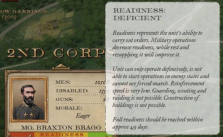Transport Guide for Grand Tactician: The Civil War (1861-1865)
Using The Transports
Readiness consumption: Readiness is consumed when the unit is moving. The rate of consumption depends on the support of the. State the unit is moving through. If state support is low, the unit will need to use further effort to scout, cover its movement, set up garrisons, and manage the lack of support from local citizens. Readiness consumption also depends mainly on the commanding. Officer A cautious officer will consume readiness much faster than an aggressive one (initiative attribute). Transporting the unit using railroads or ships will cost additional readiness, as will bad weather and winter.
When recruiting or transferring new brigades to the unit, readiness will decrease slightly, as further reorganization is required. The same is true when changing the commanding officer. The new commander will need to organize his staff and know his troops and officers before considering the unit ready for offensives. Combat and casualties will also consume readiness.
Readiness recovery: Readiness is recovered whenever the unit is not moving or engaged. When recovering, the organizational skills of the commanding officer are needed. For this reason, units with a commander skilled in administration will recover from low readiness faster. Smaller units will also recover more quickly than large ones. The size is calculated from the number of brigades or ships.
Following conditions will influence the speed of recovery negatively:
– Poor supply rating
– Number of units/ships that have not yet arrived,
– Low morale,
– Bad weather,
– Poor intelligence gathering,
– Low training of the troops
– Winter quarters,
– Siege combat.
When a unit uses a transport, its NATO icon will display ‘additional visual information beneath it. The soldiers will be replaced with the appropriate transport in the zoomed-in map view.
With Military III policy, the military establishes a military railroad organization (such as the U.S. Military Railroad), which will reduce the cost of upkeep and increase movement speed.
Hint:
Using waypoints (hotkey: Left CTRL÷RMB) allows you to determine the route more accurately, such as using amphibious movement along waterways. Remember to give the instruction to utilize transports when planning the first waypoint (using the movement panel).
Combat Effects
Units on transports can engage in limited combat. If an army embarked upon river or sea transports engages a coastal fort, the embarked unit will fight, but with significantly reduced efficiency. If an enemy fleet intercepts the transported army, it will suffer casualties and be forced to retreat.











